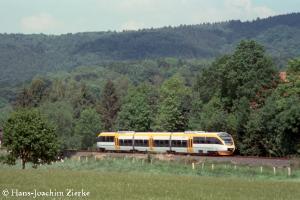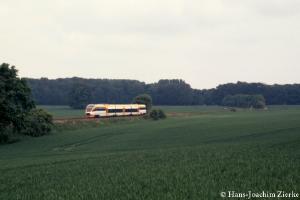Me as a foamer - first try
When writing some more pages for my Shasta Route article, I searched the web for example pictures of small-town transit operations in Germany. An obvious question: "Why not taking some pictures myself?" In August, I might have some opportunity for it, and upstairs, a collection of metal and glas can be found. Not used for many years, old equipment, manufactured in the 1970s and 80s, without as hypermodern a feature as autofocus. After opening the bags, I detected a film still sitting in a camera body, plus a test film ready for use in one bag.
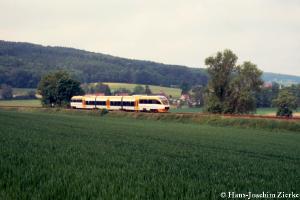
Talent DMU of Eurobahn in front of Börninghauser Masch ...
In bygone days, when I took more pictures, Kodak used to send some samples of new products. That explains the test film: "Sample. Not for resale. Ektachrome E200." And the fine print: Good for "09/1999". 05/2004 - 09/1999 =...ahem. After storage in the refrigerator, this might still work, but in the camera bag, such film is for the garbage can. "Perfect for familiarizing myself with train photography," I said to myself. "Some worthless films, and for development and scanning, I can use the offers of the local supermarket. It won't do any harm to these films."
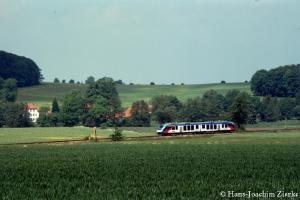
Alstom owns one of its "LINT 41" as a demonstrator. On loan to Eurobahn, it passes Gut Crollage and the old-style approach
signal of the station Holzhausen-Heddinghausen.
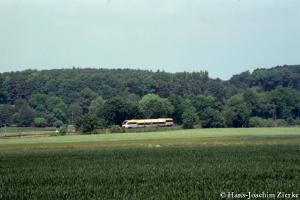
In less than two minutes, this Eurobahn DMU will reach the station of Holzhausen-Heddinghausen.
So I packed my bicycle with a camera bag, and traveled to the nearby location of "Neue Mühle", in search for some acceptable photo locations. On the KBS 386 Bünde - Rahden, the Eurobahn runs hourly DMU traffic with "Talent" units. The line was bound for closure, but rescued by the railroad reform in Germany, which transferred both the responsibility and the money for local railroad operation from the Federal Republic to the states. While the traffic on this line used to be a sad sight, hourly modern trains on memory schedule habe brought back 4-digit usage numbers.
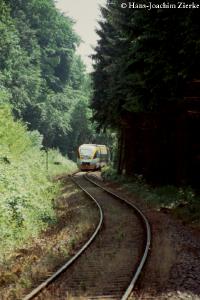
At Neue Mühle, the track passes through some hills, called Wiehengebirge.
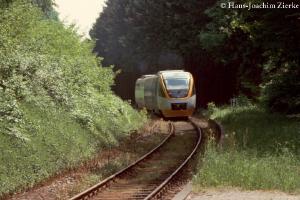
When the author was a young boy, the station of Neue Mühle attracted a considerable number of tourists.
As expected, the results of my first foaming experiment aren't impressive. But since I haven't seen any good pictures of this line in the web, I put them online nonetheless. While the expired films didn't catch perfect colors, I have to call them quite forgiving after all these years.
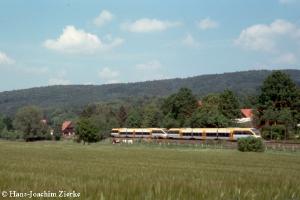
For traffic peaks, the Eurobahn operates with double traction. Here seen with the Wiehengebirge hills in background.
My quality as a foamer is limited, though: I have no idea of the unit numbers at the pictured trains. But at least, I can give you some data about the trains in use:
| Bombardier Talent, BR 643 | Alstom Coradia LINT 41 |
|
|---|---|---|
| Axle arrangement | B'(2)(2)B' | B'(2)B' |
| Length | 43,86 m (143.9 feet) | 41,81 m (137.2 feet) |
| Width | 2.925 m (9.6 feet) | 2.75 m (9 feet) |
| Capacity | 120 seats, 17 folders, 150 standees | 115 seats, 15 folders, 100 standees |
| Floor height at entrance | 59 cm (23.2 inches) | 58 cm (22.8 inches) |
| Restrooms | 1 (accessible) | 1 (accessible) |
| Weight, empty | 72.7 t (80.1 tons) | 63.5 t (70 tons) |
| Power | 2x 315 kW (845 hp) | 2x 315 kW (845 hp) |
| Transmission | hydromechanical | hydromechanical |
| Top speed | 120 km/h (75 mph) | 120 km/h (75 mph) |
| Price | 1.85 million $ in 1999 | 1.85 million $ in 1999 |
For traffic with shorter stop distance, the Bombardier Talent has been sold in a high-performance version with 2x 505 kW (1354 hp) and more doors.
© Hans-Joachim Zierke Written: 2004-06-03 Last modified: 2005-04-06
